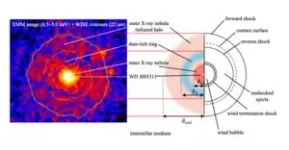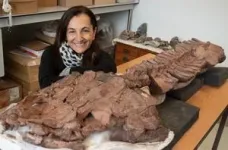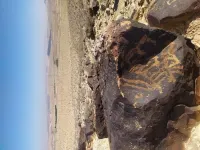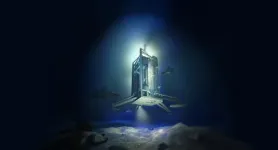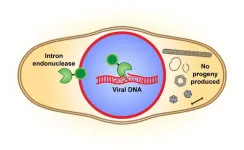(Press-News.org) A mysterious remnant from a rare type of supernova recorded in 1181 has been explained for the first time. Two white dwarf stars collided, creating a temporary “guest star,” now labeled supernova (SN) 1181, which was recorded in historical documents in Japan and elsewhere in Asia. However, after the star dimmed, its location and structure remained a mystery until a team pinpointed its location in 2021. Now, through computer modeling and observational analysis, researchers have recreated the structure of the remnant white dwarf, a rare occurrence, explaining its double shock formation. They also discovered that high-speed stellar winds may have started blowing from its surface within just the past 20-30 years. This finding improves our understanding of the diversity of supernova explosions, and highlights the benefits of interdisciplinary research, combining history with modern astronomy to enable new discoveries about our galaxy.
It is the year 1181 and in Japan the Genpei War (1180-85) has recently begun. It will lead to a shift in political power from aristocratic families to the new military-based shogunate, which will establish itself in the coastal city of Kamakura near modern-day Tokyo. A record of this tumultuous period was compiled in a diary format in the Azuma Kagami. It chronicled not only people’s lives and key events (with varying accuracy), but other daily observations, including the appearance of a new star.
“There are many accounts of this temporary guest star in historical records from Japan, China and Korea. At its peak, the star’s brightness was comparable to Saturn’s. It remained visible to the naked eye for about 180 days, until it gradually dimmed out of sight. The remnant of the SN 1181 explosion is now very old, so it is dark and difficult to find,” explained lead author Takatoshi Ko, a doctoral student from the Department of Astronomy at the University of Tokyo.
The remnant of this guest star, labeled supernova remnant (SNR) 1181, was found to have been created when two extremely dense, Earth-sized stars, called white dwarfs, collided. This created a rare type of supernova, called a Type Iax supernova, which left behind a single, bright and fast-rotating white dwarf. Aided by observations on its position noted in the historical document, modern astrophysicists finally pinpointed its location in 2021 in a nebula towards the constellation Cassiopeia.
Due to its rare nature and location within our galaxy, SNR 1181 has been the subject of much observational research. This suggested that SNR 1181 is made up of two shock regions, an outer region and an inner one. In this new study, the research group analyzed the latest X-ray data to construct a theoretical computer model to explain these observations, and which has recreated the previously unexplained structure of this supernova remnant.
The main challenge was that according to conventional understanding, when two white dwarfs collide like this, they should explode and disappear. However, this merger left behind a white dwarf. The spinning white dwarf was expected to create a stellar wind (a fast-flowing stream of particles) immediately after its formation. However, what the researchers found was something else.
“If the wind had started blowing immediately after SNR 1181’s formation, we couldn’t reproduce the observed size of the inner shock region,” said Ko. “However, by treating the wind’s onset time as variable, we succeeded in explaining all of the observed features of SNR 1181 accurately and unraveling the mysterious properties of this high-speed wind. We were also able to simultaneously track the time evolution of each shock region, using numerical calculations.”
The team was very surprised to find that according to their calculations, the wind may have started blowing only very recently, within the past 20-30 years. They suggest this may indicate that the white dwarf has started to burn again, possibly due to some of the matter thrown out by the explosion witnessed in 1181 falling back to its surface, increasing its density and temperature over a threshold to restart burning.
To validate their computer model, the team is now preparing to further observe SNR 1181 using the Very Large Array (VLA) radio telescope based in central New Mexico state in the U.S., and the 8.2 meter-class Subaru Telescope in the U.S. state of Hawaii.
“The ability to determine the age of supernova remnants or the brightness at the time of their explosion through archaeological perspectives is a rare and invaluable asset to modern astronomy,” said Ko. “Such interdisciplinary research is both exciting and highlights the immense potential for combining diverse fields to uncover new dimensions of astronomical phenomena.”
#####
Paper
Takatoshi Ko, Hiromasa Suzuki, Kazumi Kashiyama, Hiroyuki Uchida, Takaaki Tanaka, Daichi Tsuna, Kotaro Fujisawa, Aya Bamba and Toshikazu Shigeyama. A dynamical model for IRAS 00500+6713: the remnant of a type Iax supernova SN 1181 hosting a double degenerate merger product WD J005311. The Astrophysical Journal. 5th July, 2024 DOI: 10.3847/1538-4357/ad4d99
Funding:
This research has made use of data and software provided by the High Energy Astrophysics Science Archive Research Center (HEASARC), which is a service of the Astrophysics Science Division at NASA/GSFC. This work was financially supported by Japan Society for the Promotion of Science Grants-in-Aid for Scientific Research (KAKENHI) Grant Numbers JP24KJ0672(TK), JP21J00031 (HS), JP24K00668 (KK), JP20K04010 (KK), JP20H01904 (KK), JP22H00130 (KK), JP22H01265 (HU), JP19H01936 (TT), JP21H04493 (TT), JP20K14512 (KF), JP23H01211 (AB), JP22K03688 (TS), JP22K03671 (TS), and JP20H05639 (TS). DT is supported by the Sherman Fairchild Postdoctoral Fellowship at the California Institute of Technology. TK is supported by RIKEN Junior Research Associate Program.
Conflicts of interest:
None
Useful Links:
Graduate School of Science: https://www.s.u-tokyo.ac.jp/en/
Department of Astronomy: https://www.astron.s.u-tokyo.ac.jp/en/
Research Center for the Early Universe: https://www.resceu.s.u-tokyo.ac.jp/top_en.php
Research Contacts:
Takatoshi Ko
Department of Astronomy,
Graduate School of Science,
The University of Tokyo, 7-3-1 Hongo,
Bunkyo-ku, Tokyo, 113-0033, Japan
Email: ko-takatoshi@resceu.s.u-tokyo.ac.jp
Professor Toshikazu Shigeyama
Research Center for the Early Universe
Graduate School of Science,
The University of Tokyo, 7-3-1 Hongo,
Bunkyo-ku, Tokyo, 113-0033, Japan
Email: shigeyama@resceu.s.u-tokyo.ac.jp
Press contact:
Mrs. Nicola Burghall (she/her)
Public Relations Group, The University of Tokyo,
7-3-1 Hongo, Bunkyo-ku, Tokyo 113-8654, Japan
press-releases.adm@gs.mail.u-tokyo.ac.jp
About the University of Tokyo
The University of Tokyo is Japan’s leading university and one of the world’s top research universities. The vast research output of some 6,000 researchers is published in the world’s top journals across the arts and sciences. Our vibrant student body of around 15,000 undergraduate and 15,000 graduate students includes over 4,000 international students. Find out more at www.u-tokyo.ac.jp/en/ or follow us on X (formerly Twitter) at @UTokyo_News_en.
END
Fresh wind blows from historical supernova
Elusive temporary star described in historical documents recreated using new computer model, shows it may have recently started generating stellar winds
2024-07-05
ELSE PRESS RELEASES FROM THIS DATE:
Desert-loving fungi and lichens pose deadly threat to 5,000-year-old rock art
2024-07-05
The Negev desert of southern Israel is renowned for its unique rock art. Since at least the third millennium BCE, the hunters, shepherds, and merchants who roamed the Negev have left thousands of carvings (‘petroglyphs’) on the rocks. These figures are mostly cut into ‘desert varnish’: a thin black coating on limestone rock, which forms naturally. Many represent animals such as ibexes, goats, horses, donkeys, and domestic camels, but abstract forms also occur.
Now, a study published in Frontiers in Fungal ...
Scientists map how deadly bacteria evolved to become epidemic
2024-07-04
Pseudomonas aeruginosa – an environmental bacteria that can cause devastating multidrug-resistant infections, particularly in people with underlying lung conditions – evolved rapidly and then spread globally over the last 200 years, probably driven by changes in human behaviour, a new study has found.
P. aeruginosa is responsible for over 500,000 deaths per year around the world, of which over 300,000 are associated with antimicrobial resistance (AMR). People with conditions such as COPD (smoking-related lung damage), cystic fibrosis (CF), and non-CF bronchiectasis, are particularly susceptible.
How P. aeruginosa evolved from an environmental organism into a ...
Biodegradable biomass-based aerogel for sustainable radiative cooling
2024-07-04
An aerogel made from gelatin and DNA surpasses 100% solar reflectance, yielding exceptional radiative cooling, a new study reports. It is also biodegradable. The novel approach paves the way for high-performance next-generation radiative cooling materials, promoting environmentally friendly advancements in the field. Sustainable, energy-efficient, and environmentally conscious cooling technologies are crucial for adapting to our rapidly warming world. Compared to traditional refrigeration systems, passive radiative cooling technologies consume less energy and emit fewer greenhouse gasses, making them ...
New brain-to-nerve signaling mechanism reveals potential path to migraine pain
2024-07-04
The rapid influx of cerebral spinal fluid (CSF) and protein solutes released during cortical spreading depression (CSD) in the brain activates neurons to trigger aural migraine headaches, according to a new mouse study. The findings identify a novel non-synaptic signaling mechanism between the brain and peripheral sensory system important for migraine. They also suggest potential pharmacological targets for treating the painful disorder. Migraine with aura, or an aural migraine, is a distinct headache disorder that can include sensory disturbances, such as hearing- or vision-related symptoms that precede onset of ...
Federal grid reforms alone are not enough to solve clean energy interconnection problem
2024-07-04
Although energy production from wind and solar has grown rapidly in the United States, its integration into the national electric grid has been impeded by poor grid interconnection policies, leaving thousands of new facilities for generating renewable energy waiting to be connected to the grid. In a Policy Forum, Les Armstrong and colleagues highlight the interconnection problem and discuss whether federal grid policy reforms alone are enough to address it. Armstrong et al. argue that while the US Federal Energy Regulatory Commission’s (FERC) recent orders to improve this bottleneck are a step in the right direction, fundamental issues remain unaddressed. In the ...
Uncovering “blockbuster T cells” in the gut wins NOSTER & Science Microbiome Prize
2024-07-04
In the gut, dozens of strains of bacteria exert different effects on the immune system that in turn impact our health – fending off pathogens, helping digest food and maybe even influencing behavior. But pinpointing which bacteria exert which effects has been challenging. Better understanding this process could lead to a powerful way to treat a host of diseases. For developing a method by which to zero in on individual gut bacterium’s impacts on T cells, Kazuki Nagashima, a senior research scientist at Stanford University, is the winner of this year’s NOSTER & Science Microbiome ...
Study reveals brain fluid dynamics as key to migraine mysteries, new therapies
2024-07-04
New research describes for the first time how a spreading wave of disruption and the flow of fluid in the brain triggers headaches, detailing the connection between the neurological symptoms associated with aura and the migraine that follows. The study also identifies new proteins that could be responsible for headaches and may serve as foundation for new migraine drugs.
“In this study, we describe the interaction between the central and peripheral nervous system brought about by increased concentrations of proteins released ...
Scientists discover new T cells and genes related to immune disorders
2024-07-04
Researchers led by Yasuhiro Murakawa at the RIKEN Center for Integrative Medical Sciences (IMS) and Kyoto University in Japan and IFOM ETS in Italy have discovered several rare types of helper T cells that are associated with immune disorders such as multiple sclerosis, rheumatoid arthritis, and even asthma. Published July 4 in Science, the discoveries were made possible by a newly developed technology they call ReapTEC, which identified genetic enhancers in rare T cell subtypes that are linked to specific immune ...
The dawn of the Antarctic ice sheets
2024-07-04
In recent years global warming has left its mark on the Antarctic ice sheets. The "eternal" ice in Antarctica is melting faster than previously assumed, particularly in West Antarctica more than East Antarctica. The root for this could lie in its formation, as an international research team led by the Alfred Wegener Institute has now discovered: sediment samples from drill cores combined with complex climate and ice-sheet modelling show that permanent glaciation of Antarctica began around 34 million years ago – ...
Not so selfish after all: Viruses use freeloading genes as weapons
2024-07-04
Curious bits of DNA tucked inside genomes across all kingdoms of life historically have been disregarded since they don’t seem to have a role to play in the competition for survival. Or so researchers thought.
These DNA pieces came to be known as “selfish genetic elements” because they exist, as far as scientists could tell, to simply reproduce and propagate themselves, without any benefit to their host organisms. They were seen as genetic hitchhikers that have been inconsequentially passed ...
LAST 30 PRESS RELEASES:
Making lighter work of calculating fluid and heat flow
Normalizing blood sugar can halve heart attack risk
Lowering blood sugar cuts heart attack risk in people with prediabetes
Study links genetic variants to risk of blinding eye disease in premature infants
Non-opioid ‘pain sponge’ therapy halts cartilage degeneration and relieves chronic pain
AI can pick up cultural values by mimicking how kids learn
China’s ecological redlines offer fast track to 30 x 30 global conservation goal
Invisible indoor threats: emerging household contaminants and their growing risks to human health
Adding antibody treatment to chemo boosts outcomes for children with rare cancer
Germline pathogenic variants among women without a history of breast cancer
Tanning beds triple melanoma risk, potentially causing broad DNA damage
Unique bond identified as key to viral infection speed
Indoor tanning makes youthful skin much older on a genetic level
Mouse model sheds new light on the causes and potential solutions to human GI problems linked to muscular dystrophy
The Journal of Nuclear Medicine ahead-of-print tip sheet: December 12, 2025
Smarter tools for peering into the microscopic world
Applications open for funding to conduct research in the Kinsey Institute archives
Global measure underestimates the severity of food insecurity
Child survivors of critical illness are missing out on timely follow up care
Risk-based vs annual breast cancer screening / the WISDOM randomized clinical trial
University of Toronto launches Electric Vehicle Innovation Ontario to accelerate advanced EV technologies and build Canada’s innovation advantage
Early relapse predicts poor outcomes in aggressive blood cancer
American College of Lifestyle Medicine applauds two CMS models aligned with lifestyle medicine practice and reimbursement
Clinical trial finds cannabis use not a barrier to quitting nicotine vaping
Supplemental nutrition assistance program policies and food insecurity
Switching immune cells to “night mode” could limit damage after a heart attack, study suggests
URI-based Global RIghts Project report spotlights continued troubling trends in worldwide inhumane treatment
Neutrophils are less aggressive at night, explaining why nighttime heart attacks cause less damage than daytime events
Menopausal hormone therapy may not pose breast cancer risk for women with BRCA mutations
Mobile health tool may improve quality of life for adolescent and young adult breast cancer survivors
[Press-News.org] Fresh wind blows from historical supernovaElusive temporary star described in historical documents recreated using new computer model, shows it may have recently started generating stellar winds

